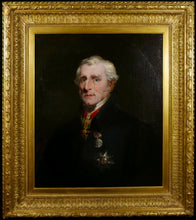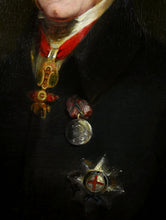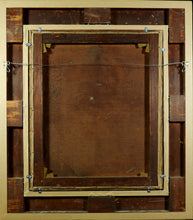Arthur Wellesley, 1st Duke of Wellington - William Salter, M.A.F., 1845
Adding product to your cart
Overall: 104cm (41in) x 93cm (36in)
Oil on canvas. Quarter length portrait facing left. Signed and dated lower left ‘W. Salter M.A.F. [Member of the Academy of Florence] / 1845’. Canvas size: 30in (76cm) x 25in (63.5in). Contained in its original gilt wood frame.
The present rediscovered portrait is a significant addition to the known portraits of Arthur Wellesley, 1st Duke of Wellington (1769–1852). In a 1935 guide to the portraits - ‘The Iconography of the First Duke of Wellington’ by Lord Gerald Wellesley & John Steegman - included mention of a Salter portrait in the Town Hall, Liverpool and describing it - ‘30 x 25: canvas: head and shoulders to L; wearing a dark coat with Golden Fleece and other Orders’. In 2014 the Liverpool portrait was described in ‘Wellington Portrayed’ (2014) as a copy ‘after Salter’ in the collection of the National Museums, Liverpool, indicating that the present portrait is the lost original.
Read more
The origins of Salter’s several portraits of the Duke lie in his magnum opus, ‘The Waterloo Banquet at Apsley House’, 1839 (Wellington Museum, Apsley House) and the access to the Duke that was facilitated by the Duke’s favourite niece Lady Burghersh (1793-1879), née Priscilla Anne Fane Wellesley-Pole, daughter of the Duke’s older brother Baron Maryborough (later 3rd Earl of Mornington) and the wife of soldier and diplomat Lord Burghersh (later 11th Earl of Westmoreland).
It is well known that Lady Burghersh was both a pupil and the indulgent patron of William Salter. She had started to paint in 1829 though it is not known by whom she was taught. Circumstantial evidence makes Salter a likely candidate. Moreover The Dictionary of National Biography suggests that Sir Thomas Lawrence, who is known to have helped other female artists, may have been instrumental in arranging her tuition. Certainly Bristol-born Lawrence was a friend of the Devon-born portraitist James Northcote, R.A. under whom Salter studied. Northcote himself had been the pupil of another Devonian portraitist Sir Joshua Reynolds. Salter became a pupil of Northcote at eighteen in 1822, perhaps in part due to his own west country origins. After five years in Northcote’s studio Salter followed in his master’s footsteps and furthered his artistic education in Italy. Salter was well received at the Florentine Academy and in 1828 was granted a teaching post as professor of history for five years. Northcote and Lawrence were both members of the Florentine Academy, Lawrence having been elected in 1820 when visiting the Burghershes, whom he knew well from their time in Paris in 1814.
After her marriage in 1811 Priscilla accompanied her musically minded soldier husband on campaign in 1813-14. In the latter year she was in Paris when her uncle the Duke of Wellington used the British embassy as a temporary gallery to promote British art. Moreover she is credited with the idea and was assisted in her endeavours by Sir Thomas Lawrence who produced his famous portrait of the Duke in 1815. 1814 was also the year of Lord Burghersh’s transfer to the diplomatic service and appointment to Florence as British minister. By the time Salter arrived in the city in 1827, Lady Burghersh had borne eight children since 1816 and had established a noted diplomatic salon, that was greatly enhanced by the widely held knowledge that she was the favourite niece and correspondent of the victor of Europe, Wellington. A letter from Lady Burghersh to Lawrence in the archives of Royal Academy dated 8 October 1828 reports her progress in painting and that she too had been admitted to the Academy of Florence.
With the Duke of Wellington’s resignation as Prime Minister in 1830 and the subsequent change of ministry, Lord Burghersh was recalled to London. They were followed home in 1833 by Salter. According to ‘Wellingtonia: Anecdotes, Maxims and Characteristics of the Duke of Wellington’ (1852), Salter was riding in Hyde Park on Waterloo Day (18 June) 1836 when he glimpsed the annual reunion of senior officers who had served under Wellington at Waterloo participating in the banquet held at the Duke's London residence, Apsley House at Hyde Park Corner. Salter was so struck by the spectacle that he approached Lady Burghersh with an idea for a painting to capture the scene. She was enthusiastic and went to her uncle with the proposal. The Duke was hesitant as he considered Salter's youth (he was thirty-two at the time) would not be up to the complexity of such a painting, but Lady Burghersh persisted and at length the Duke was persuaded. Salter was given access to Apsley House’s first floor, double height State Dining Room so he could make studies of Wyatt’s interior and the magnificent dinner service presented to Wellington in 1816 by the Portuguese Council of Regency. Over the next few years Salter made ad vivum preparatory portraits of 81 Waterloo officers while the Duke gave him sittings at Walmer Castle in 1839, and in 1841.
In spite of the Duke’s acquiescence, Salter had to tread carefully. A request to Lord Sandys, thought to have been made on Salter’s behalf, for an additional sitting at Stratfield Saye in December 1839 was met with a tirade penned to Sandys, who had served the Duke as an A.D.C. at Waterloo. ‘I am convinced that there is no Man existing or that ever lived in this Country who has sacrificed his time, his leisure, his amusements, the best hours of his days, to the Artists to the same degree that I have. I have sat for no less than six Pictures since the Prorogation of Parliament. My House at W.C. [Walmer Castle] was full of Artists. I have had three there at a time, each taking up one, two, three hours of the best of the day & I am now called upon to receive another here in the Winter, and to devote to him possibly the only Hour of Daylight that there may be in the 24 hours. Is this fair? Why should not these gentlemen do as their predecessors have? Why not copy from each other? I answer, their confounded vanity prevents it. I must sacrifice my time in order to satisfy their vanity! that each may say - This is an original Picture of the D of Wellington. I attended him at S. Saye to paint it. A l'impossible personne n'est tenue. I cannot do what is required of me Yrs Wn’ (NPG).
Salter is credited with three portraits of the Duke in ‘Wellington Portrayed’ (2014). These are a three quarters length portrait standing in military uniform with arms folded made as a ‘Study for the Waterloo Banquet’, 1839 (NPG 3766); a full length standing under an arch in military uniform with sash and star of the Order of the Garter, Order of the Golden Fleece, and the Waterloo Medal, 1839, (Purchased by the 7th Duke of Wellington in 1931); and a full length in dark uniform, possibly that of Lord Warden of the Cinque Ports, (also in the Collection of the Dukes of Wellington). ‘Wellington Portrayed’ further notes a larger variant of the arch portrait at Stratfield Saye can be found at Raveningham Hall, Norfolk; while a larger variant of Cinque Ports portrait is in the National Maritime Museum (NMM BHC3085), while another of the latter was reportedly at Thonock Hall, Lincolnshire prior to being the house being demolished in 1964. Intriguingly in regard to the ‘Study for the Waterloo Banquet’ portrait, the National Portrait Gallery’s website states ‘a head and shoulders version is in Liverpool Town Hall and a copy, attributed to Lonsdale, is in the R.A.M.C. Millbank’. However, as already discussed the Liverpool Museums consider their portrait to be after rather than by Salter.
When Salter’s ‘Waterloo Banquet’ was finally finished, the Duke together with Lord Maryborough, Lady Burghersh and her brother-in-law Sir Charles Bagot visited Salter’s studio at 59 Pall Mall in early 1841 for a private view prior to public exhibition at the Threadneedle Street offices of Alderman (later Sir Francis) Moon (Essex Standard 5.2.1841). The completed painting depicted the banquet of 1836, this being the year that two reigning monarchs attended, allowing Salter to include his portraits of William IV (1765-1837) and William II of the Netherlands (1792-1849). The painting was so popular that Moon, a stationer by trade, was able to sell tickets to see it, and in 1846 an engraving by William Greatbach of the painting also sold well.

Publicity surrounding the banquet painting may have induced Salter to work up the present portrait, perhaps produced from one of the sittings given to him by the Duke, thus satisfying the demand for a from life portrait. Evidence for this was revealed during recent conservation, when it was found that the thick application of over-paint along the sitter’s left cheek was based on the delicate brushstrokes of a painted sketch. Moreover a series of painterly marks across the sitter’s hair and over his left eye were found to be an application of paint applied after the original layers had dried but crucially are not the results of over-paint from any previous restoration.
William Salter (1804-1875), the son of a tradesman, was born and raised in Honiton, Devon. At eighteen in 1822 he became a pupil of James Northcote, R.A., who was himself who painted an equestrian portrait of Wellington for Exeter Town Hall in 1829. In 1827 Salter left Northcote’s studio and embarked on his ‘Grand Tour' to Italy. He became a member of the Academy of Rome and in 1831 exhibited his history painting ‘Socrates before the Judges of the Areopagos’ to critical acclaim. He was elected a member of the Accademia Fiorentina delle belle Arti and appointed for Professor of History at the same institution for five years (1828-33). He also visited Parma where he executed copies of the principal works of Correggio for which he was elected to the Accademia Ducale di Belle Arti, Parma. Salter returned to England in 1833 to pursue his career as a portrait painter and established his studio in Pall Mall. In 1838, he paid for and painted the ‘Descent from the Cross’ altarpiece for the new church in his hometown of Honiton. Salter was a lifelong member of the Florentine Academy and he painted a range of subjects, but he is primarily known for his banquet painting and the related portraits. In 1846 he became a member, and later vice-president, of the Society of British Artists. he and his patron Lady Burghersh both exhibited at the society’s exhibitions at the Suffolk Street galleries and the British Institution. The catalogue of his exhibited works at the S.B.A. however does not include the present portrait. Salter died at his home in West Kensington and is buried at Kensal Green Cemetery, London.
Sources:
Howarth, D. (2014), The Fourth Estate: Commemorating the Duke of Wellington, 1814-1914 The British Art Journal, Vol. 14, No. 3. Lee, S. (1885-1900). Dictionary of National Biography. London: Smith, Elder & Co.
Reynolds, K.D. (2004). Oxford Dictionary of National Biography - Fane [née Wellesley-Pole], Priscilla Anne, countess of Westmorland (1793–1879)
Reynolds, K.D. (2008). Oxford Dictionary of National Biography - Fane, John ,11th Earl of Westmorland, formerly Lord Burghersh Weigall (Ed.), Lady Rose (1903). Correspondence of Lady Burghersh with the Duke of Wellington.
Timbs, J. (1852). Wellingtonia: anecdotes, maxims and characteristics of the Duke of Wellington.
Douro, Marquess of (2014). Wellington Portrayed.
Wellesley, Lord G., & Steegman, J. (1935). ‘The iconography of the first Duke of Wellington. London: J.M. Dent & Sons Ltd. William Salter, National Portrait Gallery, accessed, 10 May 2020.














